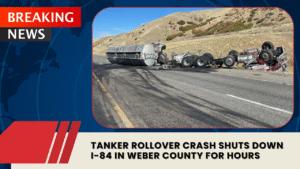When United Airlines Flight 1093 was forced to divert to Salt Lake City after its windshield mysteriously cracked midair over the Utah desert, speculation erupted across social media. Some guessed “space debris.” Others blamed turbulence or pressure failure. But one Utah hobbyist quietly pieced together what federal investigators have yet to confirm — the culprit may have been a weather balloon.
A Balloon Hunter’s Big Discovery
Ranse Parker, an engineer and longtime balloon-tracking enthusiast from Layton, noticed something strange while monitoring flight data on October 16. A WindBorne Systems balloon — launched by a California-based weather technology firm — had abruptly stopped transmitting near Moab at around 36,000 feet, the same altitude and time that United Flight 1093 reported its cracked windshield.
“I was surprised that apparently nobody else had figured this out yet,” Parker said. “I suspected it was probably a weather balloon, but when the timing and altitude matched, everything clicked.”
United’s Boeing 737 Max 8, carrying 134 passengers and six crew members, landed safely in Salt Lake City at 7:37 a.m. Passengers later boarded a new plane to Los Angeles. The National Transportation Safety Board (NTSB) is investigating the incident, and though it hasn’t confirmed the cause, Parker’s findings suggest the aircraft collided with WindBorne’s equipment — possibly a sand-filled ballast bag used to stabilize its transmitter.
A hobby that led to a national headline
Parker isn’t a random bystander. He operates multiple radio tracking stations that monitor falling weather balloons launched by government agencies, military bases, and private companies. Dozens of hobbyists across Utah do the same, sharing data through a group Parker founded called Radiosonde North America.
After posting his findings on the group’s private Facebook page, WindBorne’s communications head contacted him, confirming the company was coordinating with the Federal Aviation Administration (FAA) and asking Parker to remove the post pending investigation. The firm later deleted the balloon’s recorded landing data from its website.
WindBorne CEO John Dean acknowledged the possible collision publicly, writing that the incident appeared to involve one of the company’s devices.
What WindBorne does — and why its balloons stand out
WindBorne builds long-duration weather balloons that can hover in the atmosphere for weeks, gathering high-altitude data with the help of AI-driven forecasting models. Unlike National Weather Service balloons, which stay aloft for only a few hours, WindBorne’s carry a heavier 2.4-pound payload of sand, solar panels, wiring, and sensors.
Dean emphasized on social media that the systems comply with international weight limits and are “designed not to pose a risk to human life.” Still, he called the incident “extremely concerning and unacceptable,” confirming that one pilot was injured, though no serious harm or depressurization occurred.
Safety changes underway
In response, WindBorne announced software updates to limit the time its balloons spend between 30,000 and 40,000 feet — the same altitude used by most commercial jets. The company also said it would explore autonomous avoidance systems using live flight data and redesign its payloads to reduce potential damage in future collisions.
The FAA instructs pilots to steer clear of weather balloons and report any sightings, but the frequency of aircraft-balloon collisions remains unclear.
From hobbyist to investigator
For Parker, the discovery was a mix of luck and experience. His balloon-tracking adventures have taken him across the West, from recovering launches near Area 51 to tracking down one of only two known recoveries in Hawaii. What began as a childhood curiosity — finding an old balloon radio in the Idaho desert — has evolved into a passion that, this time, may have cracked a national aviation mystery.
“It’s fascinating where these things end up,” Parker said. “I just didn’t expect one to end up in the windshield of a jet.”


